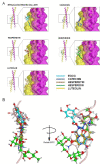CEP55 Inhibitor: Extensive Computational Approach Defining a New Target of Cell Cycle Machinery Agent
- PMID: 35517890
- PMCID: PMC9012919
- DOI: 10.34172/apb.2022.021
CEP55 Inhibitor: Extensive Computational Approach Defining a New Target of Cell Cycle Machinery Agent
Abstract
Purpose: Centrosomal protein 55 (CEP55) is a pivotal protein for cytokinesis during cell division. This study aimed to provide a comprehensive information about the CEP55 gene, including its expression pattern in several cancer types, conduct functional domain analysis across species, and perform a computational approach for potential inhibitors of CEP55. Methods: The expression levels of CEP55 in different cancers were analyzed using the Oncomine and TCGA databases. Evolutionary analysis of the CEP55 gene in various species was performed using MEGA-X software. Molecular docking analysis was used to screen the binding affinity of several natural products on CEP55-ALIX binding interaction. Results: High CEP55 expression was observed in 16 datasets of different cancer types. The high expression of the CEP55 protein was associated with worse outcomes in cancer treatments. Phylogenetic and evolutionary analyses revealed that the amino acid residues essential for CEP55 binding and localization were mostly conserved across vertebrates. Seventeen plant-based compounds were docked against the CEP55 protein to determine their binding affinities and illustrated specific sites of interaction for predicting novel protein-drug interactions. Flavanol compounds epigallocatechin gallate and catechin possessed superior binding affinity to all other compounds owing to the substitution of gallic ester or hydroxyl groups on the C3 position. Conclusion: This study provides comprehensive information about the CEP55 gene and insights for designing potent inhibitors against CEP55 signaling.
Keywords: Anticancer; CEP55 inhibitor; Evolutionary analysis; Molecular docking; Natural product.
©2022 The Authors.
Figures
Similar articles
-
Inhibition mechanism of testis-expressed gene 14 (TEX14) in cytokinetic abscission: Well-tempered metadynamics simulation studies.J Chem Phys. 2023 Jul 7;159(1):015102. doi: 10.1063/5.0153799. J Chem Phys. 2023. PMID: 37409705
-
A Comprehensive Pan-Cancer Analysis Identifies CEP55 as a Potential Oncogene and Novel Therapeutic Target.Diagnostics (Basel). 2023 May 2;13(9):1613. doi: 10.3390/diagnostics13091613. Diagnostics (Basel). 2023. PMID: 37175004 Free PMC article.
-
Structural and biochemical insights into the role of testis-expressed gene 14 (TEX14) in forming the stable intercellular bridges of germ cells.Proc Natl Acad Sci U S A. 2015 Oct 6;112(40):12372-7. doi: 10.1073/pnas.1418606112. Epub 2015 Sep 21. Proc Natl Acad Sci U S A. 2015. PMID: 26392564 Free PMC article.
-
Beyond cytokinesis: the emerging roles of CEP55 in tumorigenesis.Oncogene. 2016 Feb 11;35(6):683-90. doi: 10.1038/onc.2015.128. Epub 2015 Apr 27. Oncogene. 2016. PMID: 25915844 Review.
-
Centrosomal protein 55: A new paradigm in tumorigenesis.Eur J Cell Biol. 2020 Jun;99(5):151086. doi: 10.1016/j.ejcb.2020.151086. Epub 2020 May 20. Eur J Cell Biol. 2020. PMID: 32646645 Review.
Cited by
-
Discovery of pyroptosis-inducing natural products in neuroblastomas: computational studies with experimental validation.BMC Complement Med Ther. 2025 Jul 19;25(1):279. doi: 10.1186/s12906-025-05004-8. BMC Complement Med Ther. 2025. PMID: 40684133 Free PMC article.
-
CEP55 as a Promising Immune Intervention Marker to Regulate Tumor Progression: A Pan-Cancer Analysis with Experimental Verification.Cells. 2023 Oct 15;12(20):2457. doi: 10.3390/cells12202457. Cells. 2023. PMID: 37887301 Free PMC article.
-
Cancer testis antigens: Emerging therapeutic targets leveraging genomic instability in cancer.Mol Ther Oncol. 2024 Jan 26;32(1):200768. doi: 10.1016/j.omton.2024.200768. eCollection 2024 Mar 21. Mol Ther Oncol. 2024. PMID: 38596293 Free PMC article. Review.
-
Effect of PGV-1 on Apoptosis via Mitotic Arrest and Senescence in Polyploid Giant Cancer Cells of Hepatocellular Carcinoma JHH4.Turk J Pharm Sci. 2025 Aug 1;22(3):170-177. doi: 10.4274/tjps.galenos.2025.46837. Turk J Pharm Sci. 2025. PMID: 40746217 Free PMC article.
-
A Risk Score Model Based on Drug-Sensitivity-Related Genes Has the Potential to Predict Oral Squamous Cell Carcinoma Prognosis.Oral Health Prev Dent. 2025 Aug 5;23:391-402. doi: 10.3290/j.ohpd.c_2124. Oral Health Prev Dent. 2025. PMID: 40762677 Free PMC article.
References
LinkOut - more resources
Full Text Sources
Miscellaneous








